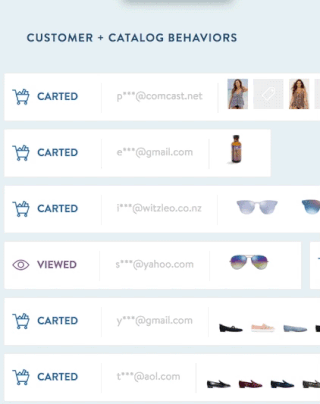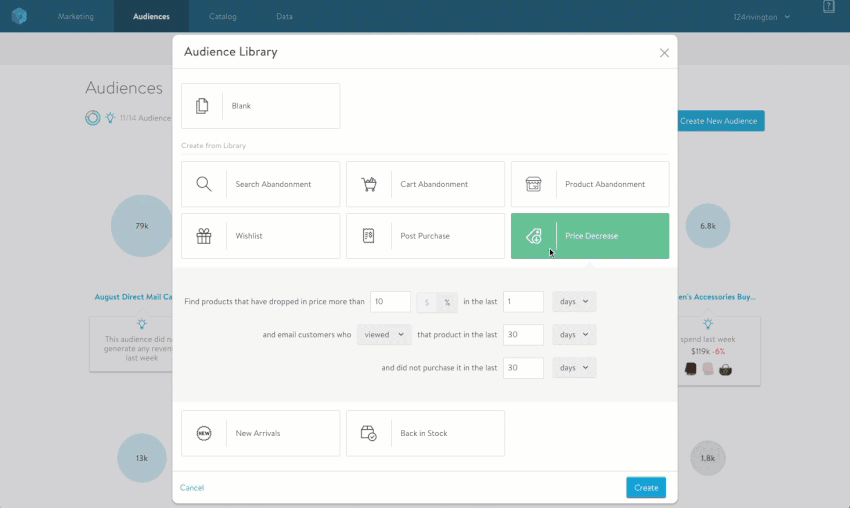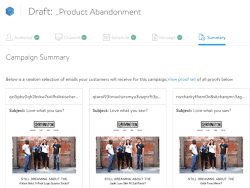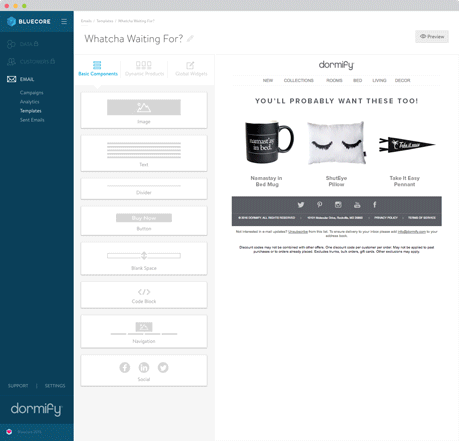
Ecommerce Email Marketing: 15 Ways to Raise the Bar on Your Campaigns
How different is email marketing today compared to 30 years ago? For many online retailers, it hasn’t changed as much as you’d expect.
Since the late 1990s, how often you check your email, where you check it, how many emails you get and the look of those emails have certainly changed. But the marketing strategy behind email hasn’t changed nearly as drastically.
Today, many ecommerce marketing teams still rely heavily on batch and blast emails. Sure, most have gotten a bit smarter by segmenting lists here and there and adding a few triggers into the mix, but that basic segmentation and trigger strategy doesn’t deliver on the high level of personalization that modern shoppers demand.
Since ecommerce companies use the internet to sell products, it’s important that their digital marketing strategy is shatterproof — and their email marketing campaigns should account for the lion’s share of their conversions.
Let’s take a closer look at what email marketing means for ecommerce companies.
What is eCommerce Email Marketing?
Ecommerce email marketing is the practice of sending messages to prospective or existing customers via email to educate, build brand loyalty or sell products. This can be as simple as bulk promotional emails or as complex as personalized triggered emails that get sent automatically to customers.
Why is eCommerce Email Marketing Important?
Given that 68% of consumers prefer to engage with brands over email, email marketing is an essential component of improving customer loyalty and driving revenue.
It also gives you an opportunity to connect with your customers. Think about it. If your brand primarily conducts business through an online store, consider how rare it is to have a 1:1 dialog with those customers.
For marketers, email also helps you give customers that true 1:1 experience. But remember – customers want personalization and that means your ecommerce marketing team has to go above and beyond the simple, impersonal newsletters or basic transactional emails. Personalized emails are a valuable way to fill that void and build authentic relationships with your customers.
10 Types of eCommerce Marketing Emails
When you begin creating an ecommerce email marketing plan, a blank email template can be an intimidating sight. After all, there are a number of different ways to reach out to customers depending on whether you’d like to attract new customers, encourage sales from existing customers or retarget customers who haven’t visited your store in a while.
With so many priorities and potential tactics, it can be difficult to know where to start. However, there are a few email types that can help you connect with customers and increase revenue while drumming up more loyalty.
Here are ten types of emails that all ecommerce businesses should have in their arsenal.
- Welcome Emails
- Best Seller Emails
- Cart Abandonment Emails
- Back in Stock Emails
- Post Purchase Emails
- Price Decrease Emails
- Product Abandonment Emails
- Replenishment Emails
- Search Abandonment Emails
- Wishlist Emails
Let’s dig into each type of ecommerce email and how they can be used in campaigns.
1. Welcome Emails
When a customer or prospect purchases a product or signs up for your mailing list, it’s crucial you make a good first impression. Starting off on the right foot isn’t just a nicety, either — a recent report by Bluecore found that welcome emails offer an average $3.61 revenue per email. That’s about three times the revenue of a typical one-off email.
Ecommerce marketers can use welcome emails in a few ways. First and foremost, these emails should thank subscribers for joining your list, offer personalized product recommendations based on the information that you have and expand upon your brand values. You can also use this as an opportunity to learn more about shoppers and gain their trust, which should help lay the groundwork for a loyal relationship.
The role of a welcome email is to set the tone for your relationship with consumers, while laying the groundwork for long-term engagement as they continue to interact with marketing messages, browse your website and shop for products. As shoppers engage with your business, your retail email marketing solution should be able to record this information and integrate it into future campaigns.
2. Best Seller Emails
Best seller emails are designed to inspire a shopper to visit your store based on items that are popular with similar shoppers. How you define a best seller is up to your marketing team, however many brands choose to use an AI-driven marketing solution that will narrow their best sellers by product category or by each shopper’s unique interests.
For example, a best-seller email focused on a specific product category might display this month’s most popular necklaces or earrings and get sent to shoppers with an affinity for those product categories.
If the email is properly targeted with relevant product recommendations, shoppers are more likely to consider purchasing the items within.
3. Cart Abandonment Emails
When a customer adds an item to their cart but doesn’t end up purchasing it, they engage in cart abandonment. Usually, a customer adding an item to their cart is one of the strongest indicators of interest, short of actually purchasing the item. For that reason, cart abandonment emails are an absolutely crucial part of any ecommerce email marketing strategy.
When creating cart abandonment emails or similar browse abandonment emails, consider including a few personalized product recommendations at the bottom. This will help encourage customers to finish their transaction while providing an additional opportunity for your store to drum up some extra revenue.
4. Back in Stock Emails
Back in stock emails often target shoppers that viewed, searched for or carted a product that went out of stock. As soon as the product is back in stock, this triggered email is deployed to this group of customers to capitalize on pent-up demand.
Notably, your team can create purchase intent through back in stock emails. For instance, when the customer receives an email that says a product they’re interested in recently sold out but is now back in stock, they’re likely to feel a sense of urgency that propels them to purchase.
However, promoting a previously sold out product is only one role of the back in stock email. These emails typically feature additional personalized product recommendations, which can encourage a customer to purchase more than just the featured product.
Back in stock emails are often quite successful at driving clicks, since about 37% of customers open those emails.
5. Post Purchase Emails
Post purchase emails are sent after a customer’s order is confirmed and can take on a few different forms. It could be a confirmation email that provides an overview of the order and shipping information, a customer service survey to gather information about your brand, an email encouraging social shares or an email designed to solicit reviews after the customer has received the product.
No matter which kind of post purchase emails your team chooses to use, they are an excellent way to touch base with customers after they buy.
Why? Customers actually notice post purchase emails. A recent analysis found that post purchase emails boast a 30.9% open rate, making it one of the most opened types of emails.
Post purchase emails provide a great opportunity to encourage continued customer engagement through personalized product recommendations or similar upselling activities.
6. Price Decrease Emails
Price decrease emails, merchandising triggered emails, provide an alert when a certain product drops in price. Price decrease emails get sent to customers whose purchasing and browsing behavior suggests they are interested in a certain type of product, but haven’t bought a specific, newly discounted product yet.
An advanced email marketing solution can automate the build and delivery of personalized price decrease emails by allowing them to operate as triggered emails. Like with behavioral triggers, your team can set up the campaign once and then the solution can automatically send emails to customers when a product that they viewed or have a predicted affinity for (but did not buy) drops in price.
Price decrease emails can provide the final nudge to encourage consumers to purchase, with research showing that they have a high conversion rate, right after cart abandonment emails.
7. Product Abandonment Emails
Wouldn’t it be nice if you could turn window shoppers into paying customers? Product abandonment emails strive to do just that. When a customer views a product, they are usually interested in it – however, for one reason or another, they don’t always add the product to their cart.
Product abandonment emails can show the exact product that the customer researched and also recommend similar products, new arrivals and best sellers in which the customer may be interested.
These emails have an especially high impact on revenue, with each personalized product abandonment email generating an average of $16.92 in revenue per click, making them nothing short of essential for a savvy email marketing team.
8. Replenishment Emails
Many ecommerce retailers have a replenishment email strategy in place, but only a select few have implemented a strategy that provides these recommendations for relevant products in a timely way.
For some companies, replenishment is rather predictable – for example, a beauty company knows that a customer should replace their mascara about every three months. But in reality, each customer has their own unique replenishment cadence. As a result, retailers need to understand each customer’s replenishment habits and send emails whenever they’re ready to purchase a new product. Acquiring this in-depth, individualized understanding of each customer requires additional insight into their purchasing behavior.
The answer to this is an email marketing solution that can evaluate your entire product catalog and harness predictive technology. Leveraging predictive analytics won’t only help you send replenishment offers at the right time, it will also help your team discover every product that consumers consider replenishable – and some of these replenishable products may surprise you.
In fact, when your business uses predictive technology in this way and then automates the send of these emails, your team could increase revenue on your replenishment emails by as much as 59%.
9. Search Abandonment Emails
Search abandonment emails are another type of browse abandonment email, similar to the aforementioned cart abandonment and product abandonment emails. When a customer searches your website to find a product but doesn’t click on any of the search results, they engage in search abandonment. There are many reasons for this – perhaps they accidentally mistyped their search query or they were unable to find a product they liked that was tagged with a broad search term.
While many ecommerce stores are interested in implementing successful search abandonment campaigns, it’s difficult to match products to broad search terms without dynamic, AI-driven product recommendations. However, when online retailers can understand a customer’s search intent, they can lead them back to the site by showing relevant products.
In fact, search abandonment emails are great for driving visitors back to the site since roughly 14.92% of customers who open a search abandonment email will click on at least one link.
10. Wishlist Emails
When a customer adds a product to their wishlist, they are often waiting for additional justification to carry through with the purchase. This may mean sending triggered emails that warn a customer the product is about to run out of stock or sending them an email the moment their wishlist item goes on sale. However, wishlists also present an opportunity for retailers to leverage a treasure trove of consumer information for more advanced targeting.
For example, imagine you are an online pet supply retailer. You notice that a new visitor is adding high-quality puppy chow to their wishlist — a variety of toys, a collar and a leash. On their own, these products are just supplies for a dog, but together they make it clear that this customer is getting ready to adopt a new puppy. This opens up a whole new world of product recommendations to include in an email; for example, potty training pads to discourage accidents, bitter apple spray to prevent gnawing and other offerings that a new pet owner may not think of.
The right ecommerce email marketing strategy will use a combination of these emails to ensure the customer is being given the right message at the right time.
5 Ways to Ensure Ecommerce Email Marketing Success
To be successful in the current retail climate, you need an ecommerce marketing strategy that delivers value to customers based on their individual needs. For most ecommerce teams, what’s possible from an email marketing standpoint solely depends on what your email service provider (ESP) can do. ESPs power some of the largest and most sophisticated email marketing programs in the world. However, to stay competitive in the world of ecommerce, it’s important to go above and beyond.
Your ecommerce business needs to supercharge the capabilities of your ESP by integrating new technology that allows for more retail personalization capabilities, faster workflows and easier decisions based on growing amounts of data.
With that in mind, here are five new strategies you can introduce to put some additional power behind your ESP:
1) Tie Together Email Behavior and Site Activity
You know how individual customers interact with your emails and you know how individual customers interact with your site, but can you tie the two together?
For example, can you easily keep a pulse on what Shopper A receives via email and what she does on your site in order to send more relevant emails and even personalize the onsite experience to match?
By tying together data in this way, you can paint a more complete picture of customer activities so that you can create a more consistent, personalized experience and better understand your customers as a whole.

2) Expand the Types of Emails You Send
We all love a good triggered email, and the amount of triggered emails that marketers send will only continue to increase in the years ahead. But are you doing enough?
Most retailers today are capable of sending emails based on basic customer behavior triggers, such as cart abandonment emails, but those emails only scratch the surface when it comes to triggered email capabilities.
One of the best ways to improve your email performance is to introduce merchandising emails that are based on data from your product catalog. With a solution that ties together product catalog data along with customer data and onsite behaviors, you can send extremely targeted merchandising triggers like price decrease, new arrivals, low inventory and back in stock alerts.
These merchandising triggers help truly grease the wheels of the ecommerce shopping experience by providing more value for customers. For example, customers may very well know that they abandoned their shopping cart, but they have no way of knowing when the price drops for items they were looking at or when that out of stock item they wanted is suddenly available again. As a result, alerting them to catalog changes like that can prove a huge value-add.

3) Improve Your Existing Batch Campaigns
In addition to expanding on your email program, you can also improve on what you’re already doing. For instance, consider the possibilities to upgrade your existing batch campaigns by making them more personal.
To be clear, ecommerce personalization is about more than just adding in your customer’s name (or any other static information they’ve shared with you for that matter). It’s about creating a unique experience for customers based on how they’ve engaged with your website, your emails and beyond.
Batch campaigns and personalization might seem at odds, but they don’t have to be. With the right tools in place, you can easily identify who you should target for different batch campaigns and what products you should show them. This effort helps make every email you send relevant and gets you closer to that holy grail of “rights” — getting the right message to the right person at the right time.
When personalizing batch campaigns, there are several approaches you can take. For instance, you can dynamically populate content, offers and product recommendations in emails based on what products individual shoppers have previously viewed or have an affinity toward, their discount affinity, predicted lifetime value and customer lifecycle stage.

4) Simplify Your Workflows to Speed Up Your Response Times
Next, it’s time to put control back into your marketing team’s hands so that they can handle new capabilities like delivering product-based personalization and introducing recommendation strategies on their own. Given the speed at which today’s market moves, you need to empower non-technical resources with tools to build beautiful and effective emails quickly and easily.
If your team is waiting on different departments to pull lists, design emails, etc., then that delays how long it takes for new campaigns to get out the door. But today’s market requires your team to react to customer behaviors in real-time, and that means marketers need the power of easy-to-use tools for all of these capabilities at their fingertips.

5) Get a Deeper Understanding of Your Data
Finally, you can empower your team to dig deep into your performance data and better understand your customers by finding new cohorts to analyze. If you’re like most email marketers, once you send an email, you slice and dice the data to see how it performed with different cohorts. But how do you decide which cohorts to evaluate and how do you determine which customers fall into those cohorts?
What you need is a solution that makes it easy to build targeted audiences based on factors like predicted customer lifetime value so that you can easily determine who falls into certain groups and then get a deeper understanding of how those valuable cohorts interact with your marketing emails.
For example, consider narrowing in on the performance of a cohort with a high predicted lifetime value, those who are at-risk or those with a high affinity toward certain product categories.
It’s Time to Raise the Bar on Your Ecommerce Email Marketing Strategy
Despite the fact that email continues to be the top channel for customer engagement, many email marketing strategies leave a lot to be desired — for both customers (in terms of personalization) and marketers (in terms of ease of bringing new campaigns to market and understanding the data behind it all). But that doesn’t have to be the case.
In fact, by integrating a solution that allows for deeper personalization, faster response times and a better understanding of customer data, your marketing team can very easily supercharge what you’re already doing. It’s just a matter of knowing where to start.




